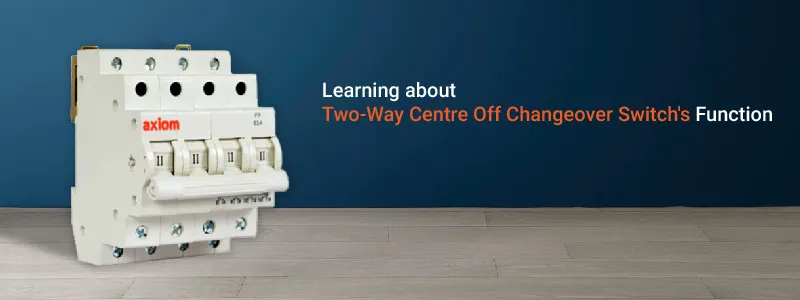
Switches are essential parts of electrical systems because they control power distribution and energy flow. The two-way centre-off changeover switch is a versatile part with a number of uses. This article attempts to give information on the two-way centre-off changeover switch’s function and applications as well as insights into its significance in electrical systems.
Definition of Two-Way Centre Off Changeover Switch:-
A two-way center-off switch, also known as a 2-way changeover switch or a two-way center-off switch, is a type of electrical switch used to switch the connection between two circuits, typically starting at a common point. The switch’s central “off” position acts as a neutral point between the two active circuits.
Key Characteristics:-
The Two-way centre-off changeover switch is the pinnacle of technological innovation. It performs well while having a tiny footprint. The double break contacts on this switch are made to be accurate and dependable, and the silver cadmium oxide contact tips increase conductivity for a longer switch life. Mounting it is simple thanks to a snap-on DIN rail that works with any electrical system. The titles “2-way MCB changeover switch,” “2-way switch,” “2-way centre off MCB switch,” and “2-way changeover MCB” emphasise this switch’s ability to switch power sources between two channels. If you need a dependable and practical switch, the two-way centre-off switch is perfect.
Usage and functionalities:-
1. Switch-up Power Sources: Shifting effortlessly between two power sources is one of the key functions of a two-way centre-off changeover switch. This switch makes it possible to quickly and reliably switch to an alternative power source in the event that the primary power source develops a problem or needs maintenance, ensuring uninterrupted electrical service.
2. Second Power Management: Critical infrastructure projects and industries frequently rely on backup generators or other power sources. During power outages, the Two-way centre-off changeover Switch enables a seamless transition between the major power grid and the backup system.
3. Load Sharing: In some applications, the two-way mcb switch is used to equally distribute the electrical load between two power sources. This can assist in reducing overloading and optimising energy usage.
4. Servicing and Restoration: The switch’s ‘off’ state enables the safe maintenance and repair of attached equipment. Technicians may operate on electrical systems without worrying about unintentional power spikes by disconnecting circuits.
5. Emergency Systems: Two-way centre-off changeover switches are necessary for emergency systems because they enable swift activation of crucial equipment in life-threatening situations, ensuring that essential activities continue uninterrupted.
6. Automation and Control: Two-way changeover switches are used in some automated systems to give remote control and operational management; this is especially useful in factories and smart building technologies.
7. Installation Considerations: Proper marking and clear identification of the “off” position are critical when installing a two-way centre-off changeover switch to avoid misunderstandings and ensure that official personnel can operate the switch safely and successfully.
To Summaries:-
The two-way centre-off switch is a versatile component that may be used in various electrical applications. Its possible uses range from monitoring power supply during outages to supporting effective load sharing in a variety of industries. By understanding its characteristics and functions, experts can take advantage of the capabilities of this switch to improve electrical systems and ensure an uninterrupted power supply.










